Jiulong Baguazhang is a complete internal martial and health method. There are very few arts taught today that contain the depth and profundity of training that Jiulong presents to its students. Here is a sample of the path one takes while training for martial arts (Zhandouli) in the Jiulong system. Dr. Painter the current Shifu of this art has developed a progressive training regimen that is capable of bringing very powerful results in all levels of internal development. Each of the eight palms is trained in these ways to develop their unique abilities.
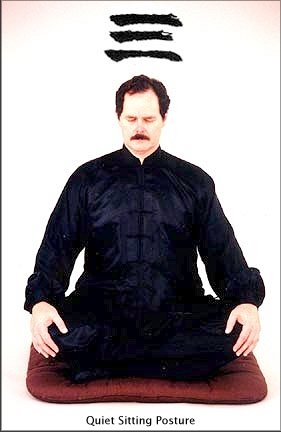 When one begins training in the “palms” of Jiulong each palm is associated with a trigram from the Yijing. The student begins by learning to recognize the Gua symbol and then learns each of the correspondences for that particular Gua.
When one begins training in the “palms” of Jiulong each palm is associated with a trigram from the Yijing. The student begins by learning to recognize the Gua symbol and then learns each of the correspondences for that particular Gua.
These correspondences will be used to form a mental image upon which the student will meditate. If learning martial art he will meditate upon the energy and Qi associations of the Gua. This meditation will take place first during Quiet Sitting practice. For example in the practice of Heaven palm the student might attempt to think of what he would act and move like if he were a huge all powerful Chinese dragon flying in the sky. He will also focus on the color and Qi meridians associated with this Gua in the Yijing.
The purpose of this practice is to build an internal association with a specific type of power or energy that will be stimulated internally and externally when practicing the shapes and postures of this particular palm. An analogy to this type of practice is similar to a person who is dieting or exercising placing a photo of an exceptionally fit, trim, strong model on the icebox and using that image as a goal to aspire to. Constantly seeing that image reinforces the goals of training to attain the ideal level of strength, power, longevity, fitness or spiritual ideals.
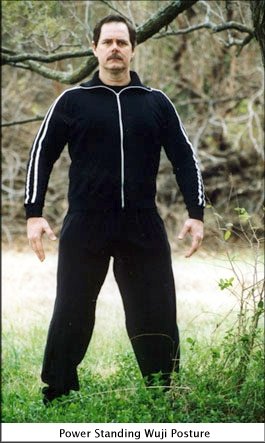 Students begin by learning the three basic power development exercises for creating neuromuscular synergy that leads to real internal strength. Dr. Painter includes scientific / medical proof of how and why standing training works to create health and internal power.
Students begin by learning the three basic power development exercises for creating neuromuscular synergy that leads to real internal strength. Dr. Painter includes scientific / medical proof of how and why standing training works to create health and internal power.
The first level of basic Baguazhang Zhan Zhuang postures teaches how to open the energy gates with the three most important postures for centering, rooting and (Jin) emitting power. On level two the student learns how to expand the consciousness and intention to surround the body for sensitivity and awareness.
From the second level the student learns how to gather physical / mental energy and project it to create a dynamic “whole body” power directed from the mind. This is the essence of the Chinese maxim that states, “The mind commands, the body moves and the Qi follows”
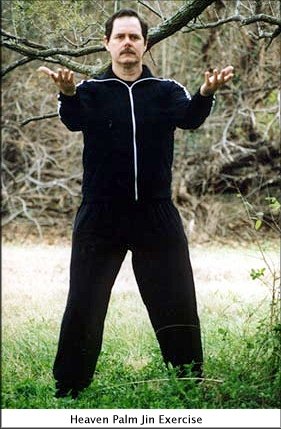 Stationary training consists of studying the connections from the ground to the palms in the simplest yet most powerful path. Students learn how to summon “whole body” force by creating a dynamic Jin path of coordinated body energy. This process begins in the feet and travels from the legs to the hips, into the torso, spine, shoulders, arms and finally the palm. Two forms of training are employed here one in horse stance position and the other shifting from side to side utilizing the Dragon and Tiger stances of Jiulong training.
Stationary training consists of studying the connections from the ground to the palms in the simplest yet most powerful path. Students learn how to summon “whole body” force by creating a dynamic Jin path of coordinated body energy. This process begins in the feet and travels from the legs to the hips, into the torso, spine, shoulders, arms and finally the palm. Two forms of training are employed here one in horse stance position and the other shifting from side to side utilizing the Dragon and Tiger stances of Jiulong training.
It is here that the student also learns how to make the body into a living Taiji and comes to understand the principles of balance and “power in reserve” energy. At each stage of the training the Shifu will help the student to test his or her progress through a series of exercises designed to show clearly if the skills are being obtained through proper practice.
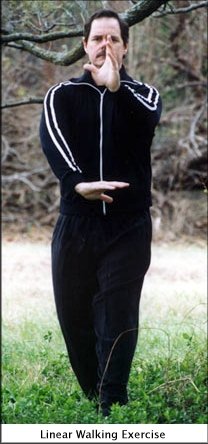 To begin understanding how to blend the mental energy derived from Quiet Sitting with the body connections developed in Power Standing and Stationary Training we examine linear walking. Here the student uses walking combined with previous knowledge to produce Jin power.
To begin understanding how to blend the mental energy derived from Quiet Sitting with the body connections developed in Power Standing and Stationary Training we examine linear walking. Here the student uses walking combined with previous knowledge to produce Jin power.
The students learns that Baguazhang uses the entire bodies muscular system like a spring, flexible, up and down and in a circle at the same time. This earlier skill is coupled with continuous movement to create momentum for even more power.
To understand how power is generated by moving in Baguazhang and how to use subtle methods of neutralizing the energy of others we study the linear methods of moving first, as this is most natural to us and then proceed to the circular walking exercises. As each palm contains numerous hand positions there are many exercises to be derived from this form of training.
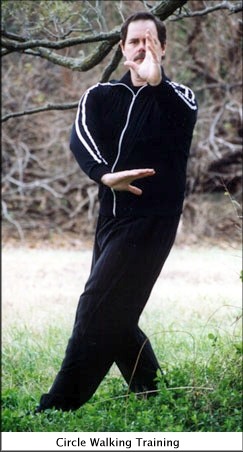 The essence of true Baguazhang is move, flow and change continuously without pause. This is what we learn from circle walking. Our goal is to be capable of instantly changing direction without losing momentum or energy. This skill is the hallmark of the Baguazhang expert. Students’ train in basic direction changes both turning inside and outside the circle, and changes using stepping patterns that allow them to spin 360° while traveling around the circle. Principles of centering, rooting and body mechanics are thoroughly studied for each tactic trained.
The essence of true Baguazhang is move, flow and change continuously without pause. This is what we learn from circle walking. Our goal is to be capable of instantly changing direction without losing momentum or energy. This skill is the hallmark of the Baguazhang expert. Students’ train in basic direction changes both turning inside and outside the circle, and changes using stepping patterns that allow them to spin 360° while traveling around the circle. Principles of centering, rooting and body mechanics are thoroughly studied for each tactic trained.
Long range goals of basic circle walking include the ability to turn inward and outward with no break in the movement. This must be accomplished with no loss of momentum before, during or after the change and maintaining a complete transfer of the momentum from the feet to the torso and into the arms at any point along the turn.
Jiulong Circle Walking Training begins with walking one circle. Next the student graduates to walking two circles in figure eight patterns. Cutting through the circles along S shaped curved paths is also part of this workout. In time another circle is added and then another until the student is finally walking, spinning and running with complete control and balance around nine circles. This is the essence of the Jiugong Dian (nine-palace training) at this point wooden posts and narrow balance beams are substituted for the circles and the external power (Waigong) training can begin.
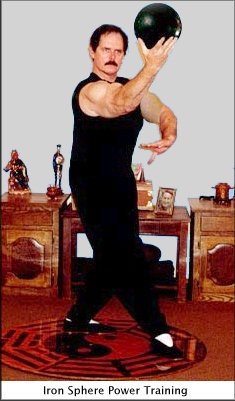 True internal martial arts contain practical methods of creating strength both internal and external. External power training is designed to create overall Musculo skeletal strength and then to begin refining this power by training the smaller muscle groups used to stabilize the body during movement. In Chinese this is known as Waigong or external skill.
True internal martial arts contain practical methods of creating strength both internal and external. External power training is designed to create overall Musculo skeletal strength and then to begin refining this power by training the smaller muscle groups used to stabilize the body during movement. In Chinese this is known as Waigong or external skill.
This type of training can be performed using modern weight equipment or the more traditional Chinese methods of using “iron spheres” and weighted rods, poles or weapons. As core body strength develops adding heavier spheres or weights increases the resistance.
Some masters of Baguazhang were known to wear leather vests weighing over 100 lb. filled with iron pellets and walk the circle slowly performing various changes while gripping iron spheres. Here Shifu Painter walks the circle with a 30-lb. stone ball in the Heaven palm posture to develop the connection of the arm to the deltoid muscles into the torso.
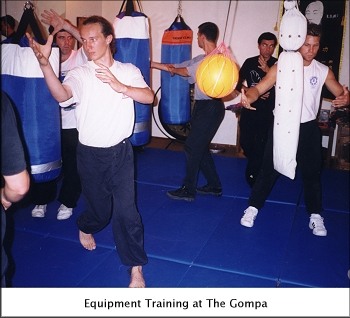 To develop combat skills the student must first learn how to apply his or her power, flexibility, awareness and sensitivity derived from the first six layers of training. Tests of one’s ability to develop and to discharge both the yin and yang types of Jin (force) are undertaken by training with various types of equipment.
To develop combat skills the student must first learn how to apply his or her power, flexibility, awareness and sensitivity derived from the first six layers of training. Tests of one’s ability to develop and to discharge both the yin and yang types of Jin (force) are undertaken by training with various types of equipment.
These include the use of heavy hanging bags for striking and bumping as well as dodging and moving to the side or behind an opponent and the use of special double-ended speed bags to develop timing and coordination for striking and dodging.
The Gompa Center is equipped with nine heavy hanging bags that can be used in a similar manner to the wooden posts except an added feature is that they can swing freely presenting a formidable obstacle course for all but the most fleet of foot.
 Jiulong Baguazhang employs various two-person games called pushing hands. These are methods designed to test one’s ability to sense the intent and direction of an opponent’s attack. The goal is to learn how to neutralize the incoming force while simultaneously taking over the attackers center of balance as you follow up with a counter throw, strike or lock.
Jiulong Baguazhang employs various two-person games called pushing hands. These are methods designed to test one’s ability to sense the intent and direction of an opponent’s attack. The goal is to learn how to neutralize the incoming force while simultaneously taking over the attackers center of balance as you follow up with a counter throw, strike or lock.
Play involves several layers of testing and developing one’s skills. Students work in a non-combative atmosphere with the overall objective of helping each other learn correct application of principles. Because each palm has it’s own unique type of energy and special principles. As one progresses in the art and studies other palms these games become quite intricate and challenging.
 Due to the nature of Jiulong Baguazhang not to hold back or “pull” strikes it is very difficult for students to spar safely with this art. Master Li believed that to hold back or to stop a strike short during training would train your body to also pull the strike when used in a real confrontation.
Due to the nature of Jiulong Baguazhang not to hold back or “pull” strikes it is very difficult for students to spar safely with this art. Master Li believed that to hold back or to stop a strike short during training would train your body to also pull the strike when used in a real confrontation.
Application training is undertaken using a unique system of moving at three speeds. First is very slow like the speed one sees in Taijiquan forms. As the student’s ability increases the speed is increased to a normal or walking speed. Finally the most advanced students are allowed to “spar” but only if wearing full protective equipment.
If you would like to find out more about Jiulong Baguazhang and would like to talk with other students of this martial art, about the art, then you might want to consider joining our Jiulong Baguazhang Facebook Group. Click below to join.